How
was the mural at the Kleinmarkthalle made?
Teaching
a foreign language through art with the elderly
Douglas
Cooper, Artist
School of Architecture
Carnegie Mellon University
E-mail Douglas Cooper at dcooper+@andrew.cmu.edu
Professor Stephen Brockmann Department of Modern Languages Carnegie
Mellon University
Student Interns:
Anne Garibaldi, Jayakrishnan Nair, Amie Robinson, Martin Schaeffers, Rachel
Schmeidler, Christa Sherwood.
How
was the mural made?
About Douglas Cooper
Back
to Douglas Cooper
Other Murals by Douglas Cooper
CMU University Center, Pittsburgh
Courthouse Mural, Philadelphia
Heinz History Center, Pittsburgh
John's 44th St., New York
John's 65th St., New York
UCSF
Mural, San Francisco
Baker Mural
Italy Mural (new)
Articles about the Murals
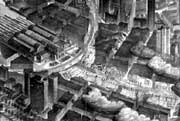
The upper frieze: the city from a
bird's-eye view
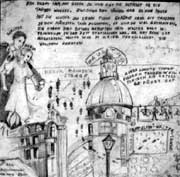
The lower frieze: a collective
sub-conscious
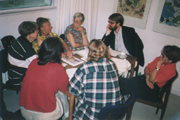
Our work had the character of a kafeeklatsch
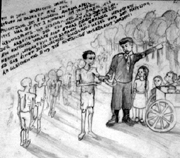
There were also tears: an atrocity at Ordruff
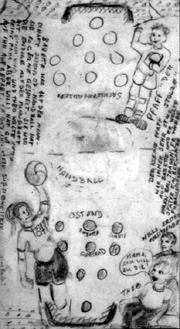
Memories of playing handball
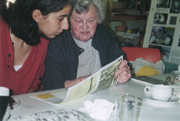
Rachel working with one of the elderly
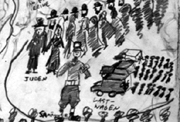
A familiy's suicide before Kristallnacht
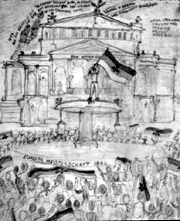
Anne's drawing of the celebration after Germany beat England in soccer
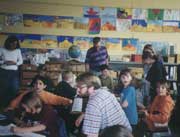
Steve at the Holzhausenschule
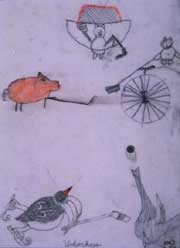
Ur Hockey (as explained by a student)
Years ago ice hockey was originally
played by animals. Each animal brought
its particular skill to the game. The penguin was an excellent skater.
The
pig was excellent at defense because it could stop the puck with its fat.
The elephant was great at shooting the puck
with its trunk. What the role of the one
on the bicycle was I do not know.
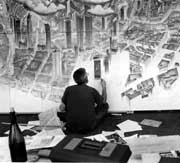
Every day I started at 5 am and worked at least until 9 pm
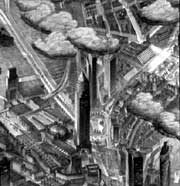
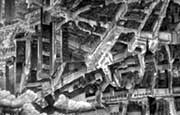
The two students from the Staedel helped with the upper frieze
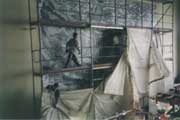
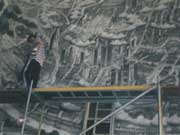
We saw the whole mural for the first time only when the scaffold was removed
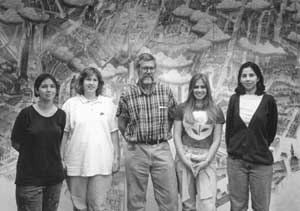
Making the mural..
After my experience of doing murals with elderly residents in Pittsburgh and Philadelphia, I began to think that it would be possible to use this same process of working with elderly as the foundation for a robust project based kind of foreign language instruction. With the production of the art work being paramount, the burden on the students' language usage would be communication, pure and simple, rather than perfect grammar or pronunciation. A more natural condition, I thought. Because I had lived in Frankfurt, Germany, for five years and was already reasonably fluent in the language, I chose German as the language and Frankfurt as the city.
The work I envisioned would have two parts. In an upper-frieze, it would present Frankfurt as it appears today from a bird's eye view from the south reminiscent of the classic view of the city produced by the Merian family in the 1600s.
A lower frieze would present the city as a collection of the memories of its inhabitants: a kind of collective subconscious of the city.
It took two years of proposal writing to get the project underway. By Spring 1996, I had a location for the work, the senior centers lined up, the students identified and the money in hand to support the whole project.
I anticipated that the work would take two months to complete. I would stay with my good friend, Joerk Habermann, for the summer. When complete, the work would be donated to the city and installed in the Kleinmarkthalle, Frankfurt's downtown central market.
We would work with four centers: the Institut fuer Sozialarbeit, the Grauen Pantern, the Seniorenwerkstatt, and the Senioreniniativ Hoechst. Money was there to cover all the material costs, pay the student interns, cover their travel and living expenses, pay for their ongoing language instruction and produce a book about the work after it was finished. Funding would come from four sources, Deutsche Bank Bauspar AG, National Endowment for the Arts, Roy A. Hunt Foundation, and Robert Bosch GmbH. Professor Stephen Brockmann, a Professor of German at Carnegie Mellon University, would join the project for one month teaching a kind of parallel tutorial and leading the students alongside myself in working with the elderly.
In mid-June, Steve and I met our team of students from Carnegie Mellon at the Frankfurt airport. The four students from Carnegie came from various disciplines: Anne Garibaldi, German, Amie Robinson, Art, Rachel Schmeidler, Art and German, and Christa Sherwood, Architecture and History. Their abilities in German were various. Anne and Rachel were quite fluent. Christa had a modest background. Amie was a beginner.
Because it was the season of white asparagus and because the studio we rented was nearby, we spent much of the first weekend at the Dippegucker, a restaurant specializing in local dishes, to acquaint the students with green sauce and applewine. That restaurant quickly became our favorite meeting place and applewine and green sauce our primary fuels.
In the first week at the Institut fuer Sozialarbeit in Rothshild Park, we immediately began work with groups of elderly from throughout the city. We worked in two groups, one led by Steve and one by myself. I assigned Anne and Rachel to separate teams so that each team would have one fluent student. Each team met with 3-5 elderly at a time.
Our work had something of the character of a Kafeeklatsch. We sat around large tables and talked about past experiences. Sometimes these conversations focused on the experiences of a particular neighborhood; the discussions of city districts such as Bornheim emerged in this way. However sometimes they concerned broader themes; the experiences of the War or of the immediate post-war years were to a large degree shared by all.
At still other times the discussions were more personal and intimate and might involve some unique adventure or event. Broadly speaking, our work touched the full range of experience: from rich every day themes such as favorite bars and movie stars, styles of dress and favorite foods, to the horrors of the war and the Holocaust. Its emotional content was broad as well. Many reports were funny. Many were tragic. There was much laughter, but also many tears.
Simultaneous to these intensive discussions, we developed charcoal and pencil drawings to capture the stories. These were done at a small format, approximately 8-1/2"x 11". Most of the drawings that appear in the mural were developed "on site" in real time as integral parts of the discussions. Some of the drawings, I would guess 20%, were done by the elderly themselves. Sometimes the stories were kept within the confines of single sheets of paper. At other times (and this was particularly the case when the discussion centered on a city district), the drawings would spread over several adjacent sheets.
At all times the drawing functioned as a support for the discussion. For the less fluent students in particular, drawings provided a useful crutch. Whenever words failed, the drawing was at hand as something that could be pointed at, qualified, erased or laughed about. It gave the discussion a subject and an object.
Meanwhile we were also working back in our studio in the Volksbildungsheim preparing the panels for the final work. The completed mural consists of 45 panels, each 1.00 meter-wide by 1.30 meter-high. The material of these panels is Medium Density Fiberboard or MDF, a sort of particle board. First we sealed the panels with several coats of lacquer. Then using an acrylic glue, Liquitex Gel Medium, we wrapped them in an acid-free paper front and back. This paper would form the surface on which we would draw.
At the beginning of the second week, we split our work among two locations. Steve Brockmann, Anne Garibaldi and Amie Robinson worked with The Grauen Panthern at a center in Roedelheim. Rachel Schmeidler, Christa Sherwood and I worked at the Senioren Werkstatt in Oederweg.
At times it was possible to assign one student to a single elderly subject; this more personal style always led to interesting results. In the Senioren Werkstatt Christa worked alone with an immigrant from Greece. With patience she brought him to the point that he produced a lively drawing in his own hand of a Greek social club in the western part of the city. One morning long, Rachel sat alone with a woman and out of this morning developed this woman's tragic story about a suicide of an entire Jewish family shortly before Kristallnacht.
In the background, life was going on in Frankfurt. One evening in late-June, there was a presentation of the Fritz Lang's film, "Metropolis," in the Frankfurt Opera, accompanied by the Music of the Frankfurt Philharmonic. As we came out of the Opera, the shouts in the street made it clear that Germany had just beaten England and would advance into the final of the Europa Meisterschaft.
At the end of the second week we worked with Ute Seeger's 4th Grade students at the Holzhausenschule. I engineered this point of departure from our work with the elderly as an emotional break. Because so much of our work so far had focused on the war and its horrors, the students were starting to wear under the burden.
In addition to its lighter character, this work with the children was also more speculative in nature than our work with the elderly. On the first day we asked the children to do drawings about the past, how things might have appeared way back when: how people dressed, what trains and cars were like, how it might have been in the winter when the Main froze. On the second day, we asked the children to do drawings about the future, how things might be: how people might travel, what might the Zoo be like. To act as a counterpoint to the drawings from the elderly and to represent their different premise, these drawings were all done in colored pencil.
On Monday July 8th, we began work on the upper part of the mural, the part of the mural that would present the city from a bird's-eye view. Two problems quickly emerged. One was time. The other was more formal. The work, as it was developing, seemed repetitive to me and did not evidence the fact that it had been made by more than one person.
The first solution for these problems was to dance. On the next weekend, the City put on a kilometer long dance fest, the "Sound of Frankfurt," in the central city. We were all there, and as far as it was possible in the packed street we danced like snakes.
The next morning I decided to do what I should have done all along; namely I asked the students to work more independently of my control. To each I gave a city district. Rachel got the Kaiser Strasse, the red-light district near the station, Amie the Zoo, Anne the Bergerstrasse, to the northeast of the city center, and Christa the Gallusviertel, an industrial area west of the station. I asked each of them to respond in their own way to their district and to enter it into the mural with their own personal style. I also in effect gave myself permission to enter those parts of the city that I remembered from my earlier years in Frankfurt in a more relaxed and naive style.
For Amie who loved animals the Zoo was the best imaginable assignment. Quickly her area became a jungle of wall to wall animals, and during this week a baby giraffe was also born. On her way to Sweden my oldest daughter, Laura, who had spent much of her childhood in Frankfurt, stopped in Frankfurt and entered a few animals into the Zoo herself.
By mid-July, we had concluded our work with the elderly. Steve left shortly thereafter and we were now totally focused on production.
I was working long hours. It had become clear to me that, with our installation deadline of August 12th, I would have to work a schedule of 100 hours a week for the remainder of the production phase in order to finish on time. Every day, seven days a week, I got up by 5:00 am and worked at least until 9 at night. It began to wear on me, and I felt as tired as I had ever felt in my life. I had continual fear that I would get sick and each day ate something with green sauce (it's parsley and some nine other herbs plus yogurt and packed with vitamins) in order to ward off illness. My emotions however remained vulnerable. When I heard shortly after the fact that Jill Watson, a favorite former CMU student and a very promising architect in Pittsburgh, had died in the crash of TWA 800, I came apart at the seams. I could not stop crying and could not continue to work. Without the help and understanding of my circle of friends in Frankfurt, I would not have been able to continue on the project.
It was therefore also a rescue for me when two students from the architecture program at the Staedelschule, Frankfurt's art school, joined our team as planned at the end of their semester. I immediately put them to work helping with the perspective work in the upper frieze. Soon the team, now with seven members, was proceeding at a pace at which finishing on time became a certainty.
We finished the work on the 45 panels late on the evening of Tuesday July 30th.
The next morning we began the coating of the panels with Liquitex Gloss Medium. This formed a protective surface over the paper. Because these coats had to dry, I took the rest of that day for a wonderful picnic on park land along the Nidda, a small meandering river north of the city.
After the Gloss Medium had cured for three days, we coated them with two outer layers of Liquitex Soluvar picture varnish. This varnish forms an outer moisture proof layer that will be removable with mineral spirits when it becomes dirty.
On Thursday August 8th we began installing the work from a scaffold that the city had installed in the Kleinmarkthalle. This process was made particularly enjoyable because of the help of those who had food stands in the Kleinmarkthalle. I have to say our installation team was very well fed indeed.
The last panels were put in place after the scaffold and its cover were removed. Only then was it possible for the first time to see the work as a totality. Until that time we had only been able to see the work in pieces in our studio.
The mural was officially presented to the city at a crowded Gala on the evening of Monday August 12.
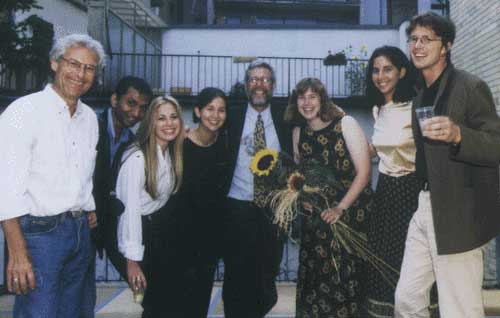
In addition to the participants, particular thanks for this project go to Dr. Hans Wiellens of the Deutsche Bank Bauspar AG, through his generosity the book was funded; Frau Evelin Schwank who very quickly brought the Institut fuer Sozialarbeit into the project and helped us with finding funding; Kasper Koenig, Rektor of the Staedelschule who helped with identifying the mural's location; Joerk Habermann with whom I spent the summer and my wife Meg who tolerated my absence for the summer.
Joerk, Jayakrishnan,Anne,Amie,myself, Christa, Rachel, Martin